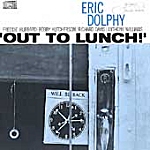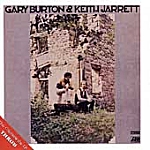New Vibesman in Town- Outline of an Instrumental Fascination. | |
 | It should be harder to define, a rarer moment to be plucked out and honoured with sparking the beginning of an adventure, but not so in this case. If you take an instrument and place it in a row alongside other sounds, other sources, other pulses, you get some idea of its versatility. In this case, hammer the hammer, and you find a kaleidoscope of colours before your eyes. And so it is with the vibes, the vibraharp, one of the nomads of the jazz world. Take for instance Train Above the City - this is NYC big yellow taxis. Chico Hamilton's quintet, the world of Weegee, but also Sweet Smell of Success. The '50s meet the '80s in some far-flung cocktail lounge: there it began, in that space between the last two Felt albums proper, a mezzanine of sorts between two peaks. But what views from that level. So it begins: the time, then, easy to define but also of another era, a nostalgic evocation of something only sensed through decadent fascination. Duffy's ivory tower imagination, filtered through rough snapshots of a place never encountered. Like hearing a muffled 78rpm recording of Casals, the mood descends but only to be modified, relived, reshaped by the lived experience of now. In a room the needle descends, and the sound of the instrument takes hold, the sound of percussion bitter sweet. What sets this album apart from any other musical document of the period must be the hypnotic effect of visiting another musical location while remaining, however tenuously, within the cartography of Felt and the range of obsessions embraced by Kerouac-hungry, make-it-rare-and-take-it-higher-Lawrence. A Lawrence in absence, so high on the ether of his aestheticism he wasn't around to play on the record: like some Kubrick orchestrating the ballet of the fallen angels around him, invisible, untouchable, but then all too palpable, camera-shy and gun-crazy. |
 | Take a leap backwards: Dolphy, fresh out of the Hamilton quintet, playing with sources, evoking the haywire highwire underground sounds of the early 60's. Playing like a spirit possessed alongside Coltrane, hurtling through 'My Favourite Things', taking it clear out of simpering whimpering Julie Andrews territory into some departure lounge to a bleaker, starker place than the Von Trapps could've faced. 'Greensleeves' or 'Edelweiss', the colours were sharper, the rhythms more urgent-and so it continued. How do you move and develop in that space? Easy- if his sound, whether sax or flute, was a caged bird clawing at its bars, a rattlesnake on a hot plate, Dolphy had more secrets in his glass menagerie. The next card to play - Bobby Hutcherson, vibesman of the moment, the result of the union, Out to Lunch! Here we have musicians playing as if their perceptions had been modified by some force-field urging them to seek more abstract, more novel connections. Move out of the jazz structures inhabited by the forces predominating at the time, explore something more deft, more elastic, a jerky new syntax creating a breathing-space in which the colours of the instruments strike at each other, pushing pulling but somehow avoiding collision or rupture of the membrane holding them together. Monkish, then, skewed, somehow adrift from the currents of the time but then fully of its time, another soundtrack to a journey, with the contours of the flute (Gazzellom referenced in a title, both a player and a way of playing, ether and benzine) being visited by the vibesman's incursions. Truly an instrumental colouring which snatched at the limited permutations current at the time, forcing new passages of lyrical expression to emerge intact and relentless in their splendour. The clanging of the celestial instrument, the ability to shade in delicately or linger in the atmosphere to set the scene for a drum solo. Dolphy's pulse rate, something more sinuous than a simple metronomic measurement, generated a new barometer for the time. Free and simple, on a tightrope of self-imposed discipline. |
 | Wind forward, spool on, and you have the hot mallets of a new renegade- Gary Burton, straight out of an apprenticeship with Hollywood sounds and the bigtime bands of George Shearing and Stan Getz. Mike him up, put him in tandem with Keith Jarrett on piano, Steve Swallow on bass, the core unit of two albums from 1969 and 1971 which Atlantic had the good sense to preserve and issue on one CD. Throb, the earlier, and candidate for most elliptical, conundrum-laden effort of all the aloof, elusive outpourings illuminating these jottings. A poison-pen letter or a valedictory hymn to the Candide-like innocence of the peace love and understanding era? Jarrett, soon to move on to fracture the shortlived harmonies explored here in his work with Dewey Redman, Charlie Haden and Paul Motian, gives a taster of the melodic freedom to be explored in the context of the K'ln concert. Here, though, the cover art says it all- captured in a rural setting, Jarrett, bare arms, poised in self-assured combative stance, Burton, frail, looking like a survivor from some honky-tonk escapade, grab your lapels and call for your attention. Throb, meanwhile, takes you further into a labyrinth of visual illusion: is the back cover a wedding of pornography and shifting walls, or a trick played in the name of refocusing your attention? Whatever the issue, as a visual accompaniment they speak volumes about a time in foment, and a nostalgia for the platitudes which made it easier to live through them. On tracks like 'In Your Quiet Place', what could be the inspiration for the more lyrical parts of Train Above the City seems clear. Reflective, evocative of a time without tension, unruffled calm unfurls, but moving into the more chaotic ebb and flow of 'Como en Vietnam'. What more telling juxtaposition than hearing the two poles move into each other. Throb visits these hallucinatory outposts of the imagination with the addition of violin to the mixture- bypassing the temptation to lay down more accessible forms, the scene shifts to a farmyard dynamism, voices and bodies move over and alongside each other to fashion a muscular texture, unique yet instantly recognisable. This listener is hooked, and it seems that the mood common to all these records is one of struggle, search, an attempt to redefine what is pop or jazz. They move between borders, inventing new forms and sites of lyrical interaction. Onscreen, Chico and his men move along in a smoky club, Jim Hall teases sounds out of his guitar with effortless ease. Tony Curtis walks in and surveys the scene: the boy with the ice-cream face, he's too preoccupied with the force of evil with a hypnotic grip on his sister. Sweet smell of success, sweet sound of running water through leaves of grass. © Marino Guida 1999. |